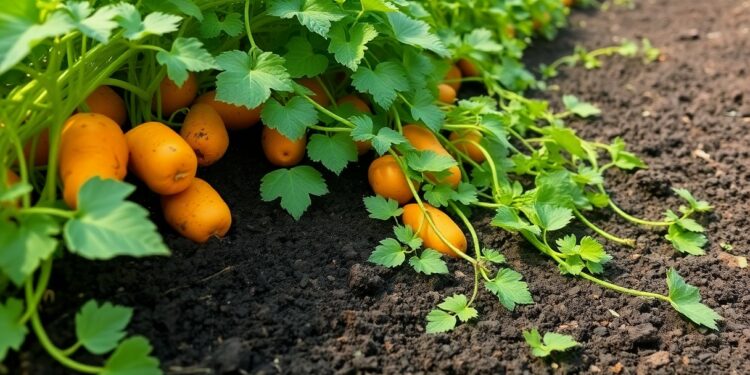Sweet and nutritious, growing sweet potatoes in your garden can be a rewarding experience! With just a little knowledge and care, you can cultivate these delicious tubers right at home. In this guide, you’ll learn the crucials to plant, nurture, and harvest your very own sweet potatoes, making your garden not only beautiful but also bountiful. So, roll up your sleeves, and let’s dig into the world of sweet potato gardening together!
Choosing the Right Variety
While there are many sweet potato varieties available, selecting the right one for your garden can make all the difference in your harvest. Each variety has its unique taste, texture, and growth habits, so you want to choose one that fits your preferences and growing conditions. Explore your options, and consider the space you have and the flavor you enjoy most for a successful sweet potato experience.
Popular Sweet Potato Varieties
You might want to try some well-loved sweet potato varieties like Beauregard, which is known for its sweet flavor, or the purple-fleshed Okinawan, celebrated for its unique color and taste. Other favorites include Covington for its reliable yield and Japanese sweet potatoes for their creamy texture. Pick one that excites your palate and suits your cooking needs!
Factors to Consider for Your Climate
Right before you plant, assess your local climate to ensure you pick the best sweet potato variety. Different types thrive in varying conditions, so it’s important to consider:
- Your average growing season length
- Soil type and conditions
- Sunlight exposure in your garden
- Possible pest or disease pressures
Thou can ensure a robust sweet potato harvest by aligning your choice with your specific environment.
Potato varieties have unique adaptations and can perform better under different climate conditions. Some are suited to cooler environments while others flourish in warm, humid weather. To make an informed decision, take the time to evaluate:
- Your zone’s temperature range
- Regional humidity levels
- Soil moisture during the growing season
- Wind patterns that influence growth
Thou will find a sweet potato variety that not only survives but thrives in your garden, leading to a bountiful harvest!
Preparing the Soil
It’s important to prepare your soil properly before planting sweet potatoes. Starting with loose, well-draining soil is key, as sweet potatoes thrive in warm, sandy loam. Make sure to till the soil at least 12 inches deep to allow the roots to spread and grow freely. Adding organic matter, such as compost, can enhance soil fertility and structure, providing your plants with a healthy environment to flourish.
Soil Testing and Amendments
The first step in preparing your soil is to conduct a soil test. This will inform you of the pH level and nutrient content, allowing you to make informed amendments. Ideally, sweet potatoes prefer a pH between 5.8 and 6.5. Depending on the test results, you might need to adjust your soil by adding lime to raise the pH or sulfur to lower it. Adding organic compost can also help balance nutrients and enhance soil health.
Tips for Ideal Growing Conditions
Ideal growing conditions for sweet potatoes include warm temperatures and well-drained soil. Here are some tips to help you create the perfect environment for your plants:
- Choose a sunny location with at least 6-8 hours of sunlight daily.
- Keep soil temperature around 65°F to 85°F for optimal growth.
- Ensure good drainage to prevent root rot.
Thou should keep an eye on these conditions to help your sweet potatoes thrive!
Soil quality plays a vital role in growing healthy sweet potatoes. You should also consider the following aspects to ensure your soil is well-suited for their growth:
- Incorporate plenty of organic matter to support soil structure.
- Avoid heavy clay soils that retain too much moisture.
- Implement crop rotation practices to maintain soil health.
Thou will find that these steps will set the stage for a successful sweet potato harvest!
Starting from Slips
You can kickstart your sweet potato journey by growing them from slips. Slips are sprouts that grow from a sweet potato and serve as the foundation for your new plants. These green shoots can be planted directly into the soil once they have reached a suitable size, allowing you to cultivate your own delicious sweet potatoes right from home.
How to Grow Your Own Slips
Some simple steps can help you grow your own slips. Start by placing a healthy sweet potato in a container of water, ensuring that half is submerged. Keep it in a warm, bright location, and in a few weeks, you’ll notice shoots emerging from the potato. Once these slips reach about 6 inches in length, you can carefully twist them off and plant them in your garden!
Tips for Purchasing Healthy Slips
Healthy slips are fundamental to a successful harvest. When purchasing slips, look for those that are robust and green, with no signs of wilting or disease. It’s also important to choose slips that have been grown in trustworthy conditions. Here are some tips to ensure you get the best:
- Inspect for healthy foliage and strong roots.
- Avoid slips with yellowing leaves or abnormalities.
- Buy from reputable suppliers specializing in sweet potatoes.
Perceiving these details can help you make the right choice for your garden.
To ensure that you select the healthiest slips for planting, consider checking the growth conditions as well. Ideally, slips should come from organically grown sweet potatoes to avoid harmful pesticide exposure. Also, don’t hesitate to ask the seller about their growing practices and any guarantees on quality. These details can enhance your chances of having a bountiful crop.
- Look for slips that are stored in a cool, dry place.
- Choose slips that have been recently harvested.
- Seek recommendations from local gardeners for trusted sources.
Perceiving the advantages of quality slips can pave the way for a successful sweet potato harvest.
Planting Your Sweet Potatoes
Many gardeners find that planting sweet potatoes is a rewarding experience. You can achieve the best results by choosing healthy slips or whole sweet potatoes and ensuring they are planted at the right time. With the right conditions and care, your sweet potatoes will thrive and reward you with a delicious harvest.
When and How to Plant
Some of the best times to plant sweet potatoes are late spring to early summer when the soil temperature reaches at least 65°F. You can plant your slips in well-drained soil, making sure to bury two-thirds of each slip to encourage growth. Water them thoroughly after planting, and watch as they grow into a bountiful crop!
Spacing and Depth Considerations
Little thought should be given to how far apart you place your sweet potato slips. Ideally, you want to space them about 12 to 18 inches apart, allowing enough room for the vines to spread and develop. The planting hole should be around 4 to 6 inches deep, ensuring that the slips are securely anchored while also leaving sufficient space for root development.
Potatoes thrive on proper spacing and depth, so it’s important to give them room to grow. When planting, consider rising mounds or rows to improve drainage and airflow, supporting healthy plants. By allowing ample space, you not only enhance their growth but also make harvesting easier when the time comes. Keep soil moist but not waterlogged, and you’ll set the stage for a fantastic sweet potato yield!
Caring for Your Sweet Potatoes
Not only do sweet potatoes require sunlight and space to grow, but proper care is also crucial to ensure a bountiful harvest. You’ll want to keep an eye on their watering needs and fertilization schedule to make sure they thrive in your garden.
Watering and Fertilization Tips
Even with the right soil, your sweet potatoes will need consistent moisture and nutrition. Here are some tips to help you:
- Water deeply and regularly, particularly during dry spells.
- Use a balanced fertilizer once a month to promote growth.
- Avoid over-fertilizing as this can lead to lush foliage but fewer tubers.
Knowing these tips, your sweet potatoes will flourish all season!
Pest and Disease Management
Pest issues can arise with sweet potatoes, like any garden plant, so vigilance is key. You might encounter pests such as aphids, spider mites, or whiteflies that could harm your plants. Keeping the garden clean and removing any affected leaves promptly can help greatly.
Management of pests and diseases relies on regular monitoring of your plants and maintaining good garden hygiene. Implementing crop rotation and using organic pest deterrents can also be effective ways to keep your sweet potatoes healthy and thriving. Always be proactive to ensure your sweet potatoes can grow healthy and delicious!
Harvesting Your Sweet Potatoes
Unlike other vegetables, sweet potatoes thrive underground and can be a delight to harvest. You’ll want to give them enough time to mature, usually in about 90 to 120 days after planting. Look for the right conditions—after the leaves start to yellow and before the first frost—so you can enjoy those delicious sweet potatoes at their best.
Signs Your Sweet Potatoes Are Ready
Your sweet potatoes are ready for harvest when the vines begin to yellow, signaling that the tubers have reached their full size. Additionally, check the soil’s temperature; when it cools down to around 50°F (10°C), it’s a good indication that the sweet potatoes are not only ripe but also have enhanced sweetness and flavor!
Best Practices for a Successful Harvest
An effective harvest begins with gentle digging to avoid damaging the sweet potatoes. Use a garden fork or spade to carefully loosen the soil around the plant without piercing the tubers. This helps you lift them out easily. After harvesting, it’s important to brush off excess dirt without washing them. Instead of water, allow them to cure in a warm, humid spot for about a week to enhance their sweetness and improve their storage life.
Sweet potatoes benefit from proper handling post-harvest to ensure optimal flavor. Provide a soft surface for harvested sweet potatoes to rest on, avoiding any rough treatment. After a week of curing, store them in a cool, dark place, maintaining high humidity to keep them fresh longer. Following these practices will ensure that you enjoy your homegrown sweet potatoes throughout the season!
Final Words
Now that you know how to grow sweet potatoes, you can enjoy the rewarding experience of watching them thrive in your garden. With just a little patience, the right soil, and some sunlight, you can cultivate delicious, nutritious sweet potatoes for your family. Whether you’re planting slips, ensuring proper watering, or harvesting your crop, each step brings you closer to a bountiful harvest. Enjoy the journey, and happy planting!

















